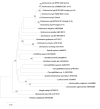Zoonotic Onchocerca lupi infection in dogs, Greece and Portugal, 2011-2012
- PMID: 24274145
- PMCID: PMC3840859
- DOI: 10.3201/eid1912.130264
Zoonotic Onchocerca lupi infection in dogs, Greece and Portugal, 2011-2012
Abstract
Onchocerca lupi infection is reported primarily in symptomatic dogs. We aimed to determine the infection in dogs from areas of Greece and Portugal with reported cases. Of 107 dogs, 9 (8%) were skin snip-positive for the parasite. DNA sequences of parasites in specimens from distinct dog populations differed genetically from those in GenBank.
Keywords: Greece; Onchocerca lupi; Portugal; dogs; infection; parasites; zoonoses.
Figures


References
Publication types
MeSH terms
Associated data
- Actions
- Actions
- Actions
- Actions
LinkOut - more resources
Full Text Sources
Other Literature Sources
Medical
